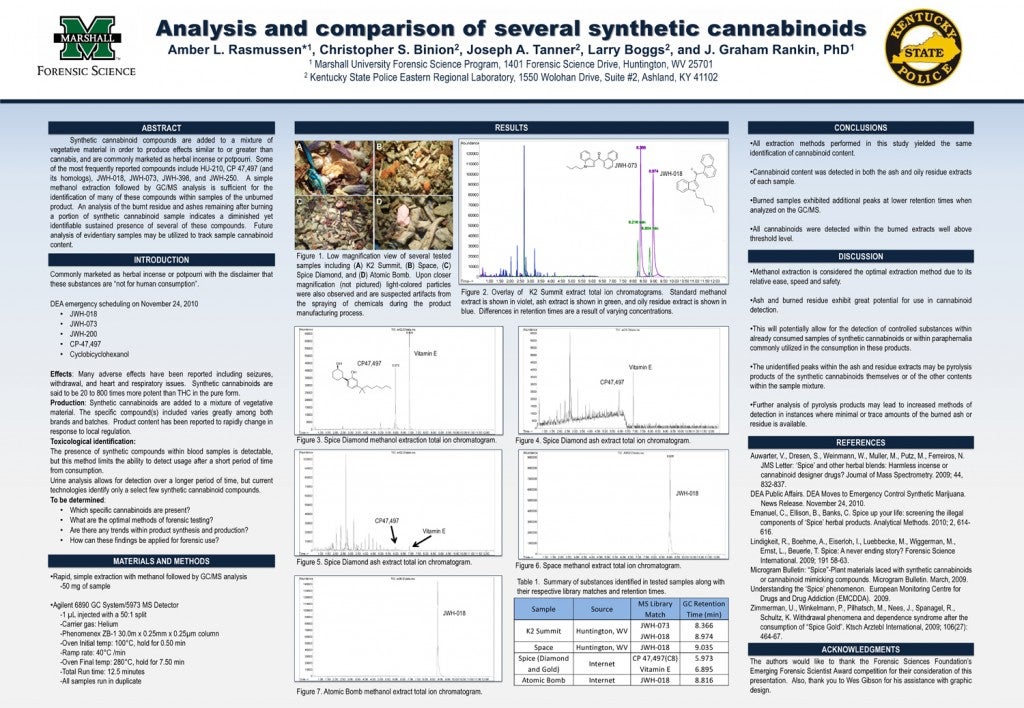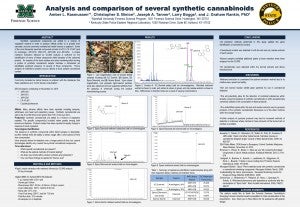
Analysis and characterization of several varieties of synthetic cannabinoids
Biography:
Amber Rasmussen is from Appleton, Wisconsin. She graduated from the University of Wisconsin-Green Bay in 2007 with a Bachelors of Science degree in Biology and Human Biology with minors in Chemistry and Spanish. She is currently a graduate student in Marshall University’s Forensic Science Program with emphases in DNA Analysis, Computer Forensics, and Crime Scene Investigation. Her poster is entitled “Analysis and characterization of several varieties of synthetic cannabinoids.”
Abstract:
Synthetic cannabinoid compounds are added to a mixture of vegetative material in order to produce effects similar to or greater than cannabis, and are commonly marketed as herbal incense or potpourri. Some of the most frequently reported compounds include HU-210, CP 47,497 (and its homologs), JWH-018, JWH-073, JWH-398, and JWH-250. A simple methanol extraction followed by GC/MS analysis is sufficient for the identification of many of these compounds within samples of the unburned product. An analysis of the burnt residue and ashes remaining after burning a portion of synthetic cannabinoid sample indicates a diminished yet identifiable sustained presence of several of these compounds. Future analysis of evidentiary samples may be utilized to track sample cannabinoid content.
Poster:
References:
- Auwarter, V., Dresen, S., Weinmann, W., Muller, M., Putz, M., Ferreiros, N. JMS Letter: ‘Spice’ and other herbal blends: Harmless incense or cannabinoid designer drugs? Journal of Mass Spectrometry. 2009; 44, 832-837.
- DEA Public Affairs. DEA Moves to Emergency Control Synthetic Marijuana. News Release. November 24, 2010.
- Emanuel, C., Ellison, B., Banks, C. Spice up your life: screening the illegal components of ‘Spice’ herbal products. Analytical Methods. 2010; 2, 614-616.
- Lindigkeit, R., Boehme, A., Eiserloh, I., Luebbecke, M., Wiggerman, M., Ernst, L., Beuerle, T. Spice: A never ending story? Forensic Science International. 2009; 191 58-63.
- Microgram Bulletin: “Spice”-Plant materials laced with synthetic cannabinoids or cannabinoid mimicking compounds. Microgram Bulletin. March, 2009.
- Understanding the ‘Spice’ phenomenon. European Monitoring Centre for Drugs and Drug Addiction (EMCDDA). 2009.
- Zimmerman, U., Winkelmann, P., Pilhatsch, M., Nees, J., Spanagel, R., Schultz, K. Withdrawal phenomena and dependence syndrome after the consumption of “Spice Gold”. Ktsch Arztebl International, 2009; 106(27): 464-67.
